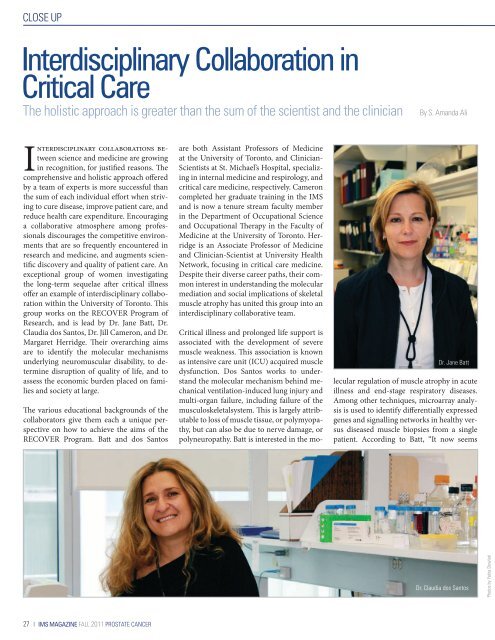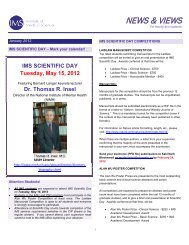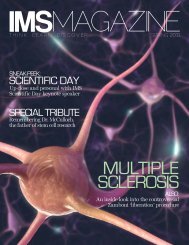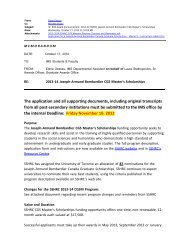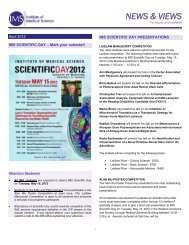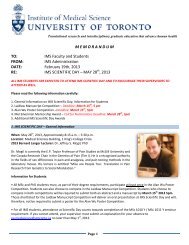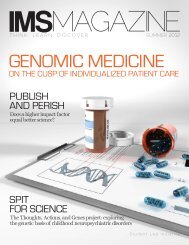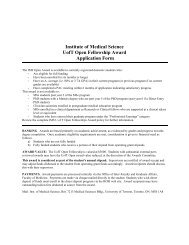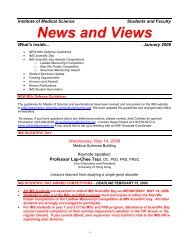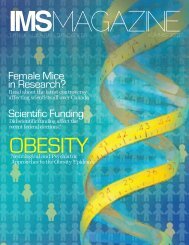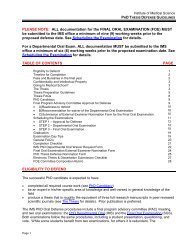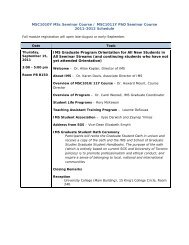Fall 2011 - Institute of Medical Science - University of Toronto
Fall 2011 - Institute of Medical Science - University of Toronto
Fall 2011 - Institute of Medical Science - University of Toronto
You also want an ePaper? Increase the reach of your titles
YUMPU automatically turns print PDFs into web optimized ePapers that Google loves.
CLOSE UP<br />
Interdisciplinary Collaboration in<br />
Critical Care<br />
The holistic approach is greater than the sum <strong>of</strong> the scientist and the clinician<br />
By S. Amanda Ali<br />
Interdisciplinary collaborations between<br />
science and medicine are growing<br />
in recognition, for justified reasons. The<br />
comprehensive and holistic approach <strong>of</strong>fered<br />
by a team <strong>of</strong> experts is more successful than<br />
the sum <strong>of</strong> each individual effort when striving<br />
to cure disease, improve patient care, and<br />
reduce health care expenditure. Encouraging<br />
a collaborative atmosphere among pr<strong>of</strong>essionals<br />
discourages the competitive environments<br />
that are so frequently encountered in<br />
research and medicine, and augments scientific<br />
discovery and quality <strong>of</strong> patient care. An<br />
exceptional group <strong>of</strong> women investigating<br />
the long-term sequelae after critical illness<br />
<strong>of</strong>fer an example <strong>of</strong> interdisciplinary collaboration<br />
within the <strong>University</strong> <strong>of</strong> <strong>Toronto</strong>. This<br />
group works on the RECOVER Program <strong>of</strong><br />
Research, and is lead by Dr. Jane Batt, Dr.<br />
Claudia dos Santos, Dr. Jill Cameron, and Dr.<br />
Margaret Herridge. Their overarching aims<br />
are to identify the molecular mechanisms<br />
underlying neuromuscular disability, to determine<br />
disruption <strong>of</strong> quality <strong>of</strong> life, and to<br />
assess the economic burden placed on families<br />
and society at large.<br />
The various educational backgrounds <strong>of</strong> the<br />
collaborators give them each a unique perspective<br />
on how to achieve the aims <strong>of</strong> the<br />
RECOVER Program. Batt and dos Santos<br />
are both Assistant Pr<strong>of</strong>essors <strong>of</strong> Medicine<br />
at the <strong>University</strong> <strong>of</strong> <strong>Toronto</strong>, and Clinician-<br />
Scientists at St. Michael’s Hospital, specializing<br />
in internal medicine and respirology, and<br />
critical care medicine, respectively. Cameron<br />
completed her graduate training in the IMS<br />
and is now a tenure stream faculty member<br />
in the Department <strong>of</strong> Occupational <strong>Science</strong><br />
and Occupational Therapy in the Faculty <strong>of</strong><br />
Medicine at the <strong>University</strong> <strong>of</strong> <strong>Toronto</strong>. Herridge<br />
is an Associate Pr<strong>of</strong>essor <strong>of</strong> Medicine<br />
and Clinician-Scientist at <strong>University</strong> Health<br />
Network, focusing in critical care medicine.<br />
Despite their diverse career paths, their common<br />
interest in understanding the molecular<br />
mediation and social implications <strong>of</strong> skeletal<br />
muscle atrophy has united this group into an<br />
interdisciplinary collaborative team.<br />
Dr. Jane Batt<br />
Critical illness and prolonged life support is<br />
associated with the development <strong>of</strong> severe<br />
muscle weakness. This association is known<br />
as intensive care unit (ICU) acquired muscle<br />
dysfunction. Dos Santos works to understand<br />
the molecular mechanism behind mechanical<br />
ventilation-induced lung injury and<br />
multi-organ failure, including failure <strong>of</strong> the<br />
musculoskeletalsystem. This is largely attributable<br />
to loss <strong>of</strong> muscle tissue, or polymyopathy,<br />
but can also be due to nerve damage, or<br />
polyneuropathy. Batt is interested in the molecular<br />
regulation <strong>of</strong> muscle atrophy in acute<br />
illness and end-stage respiratory diseases.<br />
Among other techniques, microarray analysis<br />
is used to identify differentially expressed<br />
genes and signalling networks in healthy versus<br />
diseased muscle biopsies from a single<br />
patient. According to Batt, “It now seems<br />
Dr. Claudia dos Santos<br />
Photos by Yekta Dowlati<br />
27 | IMS MAGAZINE FALL <strong>2011</strong> PROSTATE CANCER


